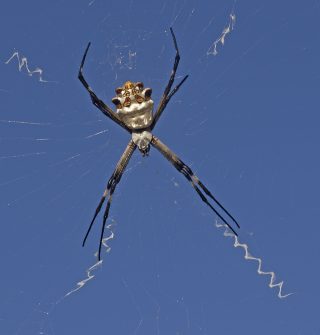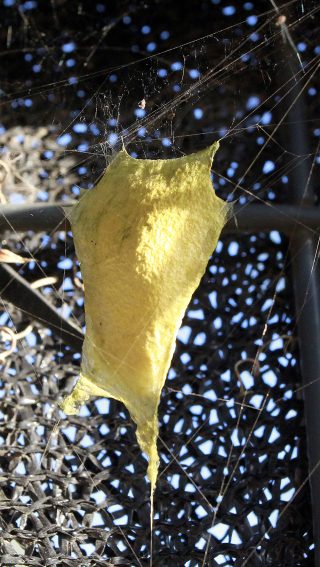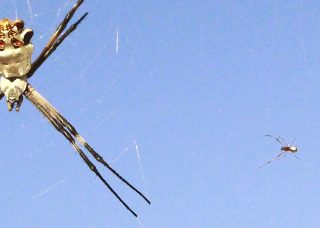
This female Silver Argiope spider looks more like an alien robot or “Transformer” toy than a spider! She has taken up residence near our dog kennel for the summer. She places herself head down in the web with her legs aligned to the thickened, zigzag bands of silk known as the stabilimentum. Robert Benson photo.
22 Jul 2016 – Silver “Transformer” Spider is “Gucci”
At first glance, it appeared to be an ordinary Yellow Garden Spider, the kind with yellow and black bands on its legs. It had spread its web in the space between the dog kennel and the well house. Since we do not walk in that space, we paid scant attention to the spider. It grew big, and then bigger, but still we ignored it.
All that changed when our grandson came to visit. He noticed it at once. “Wow! Look at that big silver spider! It looks like it is wearing a golden crown! It’s Gucci!!!” His enthusiasm was contagious. We looked at it, too.
Indeed its body was a shiny, metallic silver color. It looked like a jeweler had buffed it with silver polish. I had never seen a spider so metallic. I thought all spiders were rather “hairy.”
Looking closely at the spider we realized that it was hanging upside down in the web. What our grandson thought was a crown on its head was actually the back end of the spider! Its abdomen ended in ten triangular facets colored gold and black. To me it resembled an ancient Persian headdress.
Or some kind of machine. Then it hit me: this spider looked like a robotic machine that could open up flaps and transform itself into some other kind of machine. In other words, it looked like a “Transformer” from the popular kids’ toy line.

Near her web, and under the shady corner of the dog kennel, I found the Silver Argiope’s egg sac. She guards it until the baby spiders emerge. Whether she will feed and protect them after hatching (and not eat them!) remains to be seen. Robert Benson photo.
Apparently, I was not the only one to think it resembled an alien robot because when I entered “silver spider” on Google, an image came up labelled “Silver Transformer Spider!”
Other common names were Silver Garden Spider, Silver Orb-weaver, and Silver Argiope (pronounced AR-gee-OH-pee). Silver Argiope spiders are garden spiders that build “orb type” webs, circular webs with radial spokes. The scientific name, Argiope argentata, refers to this garden orb-weaver’s silvery color. The closely related Yellow Garden Spider (Argiope aurantia) is in the same genus.
As I read the information on several sites, it became apparent that the Silver Argiope is not a well-researched species. One site said that females average 12mm (a half inch) long, while another said they could be 35mm long. I measured our specimen and found it to be over 70mm from tip of the front legs to the tip of the back legs! That’s when I consulted John Jackman’s A Field Guide to Spiders and Scorpions of Texas (1999) and found out you don’t measure the legs. Our girl measured 25mm (about an inch) from the front of the cephalothorax to the end of the abdomen. And yes, she had to be a girl because males are never that big.

Male Silver Argiope spiders are tiny compared to the females. Females can grow to be 35 millimeters long (not counting the legs) but the males are less than one-fifth that size. Notice the tiny male in the right corner of this photo. Robert Benson photo.
I was even surer she was a female when I found her egg sac hidden in a top corner of the dog kennel. She was close enough to guard it from her nearby web. I think that her spiderlings might crawl over to the safety of her web once they hatch. I hope she is the kind of spider that will feed them and not eat them!
John Jackman’s field guide did not list the Silver Argiope as a Texas species. I was surprised until I found out that these spiders are uncommon in the United States. They are known only from the warmer, drier, and southern regions of California, Texas, and Florida. The Silver Argiope is much more common in Central and South America.
Spiders in the genus Argiope typically incorporate a vertical, zigzag band of silk in the middle of their webs. This “decoration” is called the stabilimentum. But is it for stabilizing the web, as its name suggests, or is it simply decoration? There is little agreement as to its purpose, however. Spider experts have proposed several other possible functions for the stabilimentum. Eric R. Eaton’s blog, Bug Eric, states the stabilimentum “may act as an advertisement to prevent birds from tearing into the web, but a more likely theory is that it is a fake flower designed to attract pollinating insects.” Eric Eaton goes on to say the stabilimentum reflects UV light much as some flower petals do. The mirror-like body of the Silver Argiope may also reflect UV light.
The stabilimenta of Silver Argiope spiders are a different shape than those of other spiders. Theirs are X-shaped and the female sits in the middle of the X with her legs aligned with the silken bands. This behavior gives some credence to the theory that the stabilimentum acts as a “fake flower” since this would produce a big target of reflected light.
It may be that only mature Silver Argiopes make a complete X. Younger, smaller individuals make only the outer arms of the X. Even younger spiders may make only a messy, spiral discoid in the center of the webs. And Eaton mentions one population in Bolsa Chica Ecological Reserve in southern California that has “eschewed the silken “X” in their webs” completely!
We must count ourselves lucky to live in South Texas once again. Only in a few places in the United States can we encounter such a spectacular spider as the Silver Transformer Spider. And South Texas is one of them!
If you would like to offer comments, please click through to the discussion page
